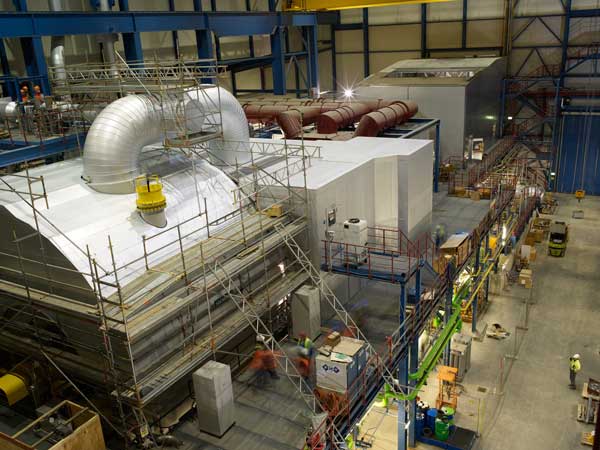Two separate performance tests—one by German technical certification agency TŨV—officially confirmed 60%+ net thermal efficiency for Siemens’ H-class gas turbine, while producing nearly 600 MW electrical output in combined-cycle operation at the Irsching Unit 4 power plant near Ingolstadt, Germany. This officially verified record achievement comes ahead of other gas turbine manufacturers pursuing the same high-efficiency goal.

The hunt for 60%-plus thermal efficiency has ended. Results of 60.43% and 60.75% net thermal efficiency, obtained at Irsching Unit 4 power plant in the first half of May 2011, have delivered Siemens Energy’s promise of highest efficiency for combined-cycle gas turbine (CCGT) power plants. Power outputs corresponding to the test runs were 550 MWe and 578 MWe, respectively. Now the era of 60%+ efficient CCGT power plants becomes a reality, bringing the benefits of energy cost savings and operational flexibility to electricity generation using a relatively clean fuel source.
A modern CCGT power plant comprises a steam turbine, generator, heat recovery steam generator, and myriad subsystems—but the gas turbine is the key element. Efficiency and performance certification of Siemens’ SGT5-8000H gas turbine is the culmination of a 10-year development program, which began in 2000 with planning the 440 metric ton, 50-Hz machine. Partnering with the customer and power provider E.ON Kraftwerke, the CCGT project was implemented in two phases at E.ON’s Irsching plant, which also served as the test bed for the gas turbine’s design validation and performance evaluations (read more at Ref. 1, below).
At this point, completion of the Irsching 4 project is essentially a formality. “The plant went into the contractual reliability run after successfully passing performance tests and will be turned into final commercial operation in July. The official inauguration ceremony is scheduled for mid-September 2011,” said Willibald Fischer, Siemens Energy’s program director for 8000H turbines.
Steadfast project commitment
Leading off presentations at a press conference for 23 international journalists at Irsching on May 19, Dr. Michael Suess, CEO of Siemens Energy Sector, referred to the achievement as “a historic moment” in power plant progress. “This technology will add a new chapter to power developments,” he said.
To execute a long-term technology development like this requires full commitment and steadfast management support. “A CCGT project cannot be based on short-term thinking or have a disruption after two years, for example,” Suess continued. “It’s very unusual that a power provider (E.ON) and an equipment supplier (Siemens) have worked together over such a long period.” Also noteworthy is that the program remained on schedule and is being completed on time.
Klaus Hammer, COO of Gas-CCGT at E.ON Generation GmbH, echoed the positive long-term cooperation involved on this project. He referred to the project milestone of 60%+ plant efficiency as an important day also for E.ON. “Worldwide that is unique performance for gas-based power generation and an example of engineering at its best,” Hammer said.
Operational flexibility plus efficiency
Fluctuating grid feed-ins are on the rise due to a growing use of newer power sources, such as wind and solar. More distributed power is coming to Germany (and elsewhere), which is a challenge for the industry, Suess explained. “Flexibility to load changes is a very important part of story,” he said—citing less than 30 minute ramp-up to peak output or from full power to shut down for the SGT5-8000H turbine (with up to 35 MW/min change rate capability). “Highly flexible power plants are increasingly critical to maintain grid stability. Part of the energy story will be gas turbines and we are witnessing a ‘game changer’ moment,” Suess added.
“Germany is on the brink of the transformation of its energy system…characterized by extensive, fast expansion of renewable power sources,” Hammer said. “Flexible power plants are required to better integrate weather-dependent renewables. This is where modern gas turbine plants come into the equation.” E.ON has already made substantial investment in combined-cycle power plants that exploit new gas turbine capabilities, Hammer explained.
Lothar Balling, head of Siemens Energy’s GT Power Plant Solutions, likewise emphasized flexibility of the 8000H gas turbine. He detailed examples of load flexibility and dynamic capability that are especially remarkable for the huge size of machines involved:
- Stable operation down to approximately 100 MW in combined-cycle mode—if needed—which is under 20% of rated plant output;
- Meeting minimum load change rate of ±10% plant capacity within 10 seconds, per grid stability requirements of the U.K. Grid Code for frequency response. This requirement was exceeded by a load increase of 64 MW (12%) within 10 s, verified by testing; and
- Meeting U.K. Grid Code requirement for island operation that calls for 45% load rejection with stable continued operation not exceeding 52 Hz frequency. Shedding of 250 MW within 6 s was verified by testing.
Point 1 above shows that the CCGT plant is applicable throughout all load ranges—whether it’s base, intermediate, or peak loading, according to Balling. “Efficiency at low loads is still that of typical peak-load, open-cycle power plants.” Point 2 has the “objective to rapidly stabilize the balance between generation and demand, according to the current frequency deviation from the 50-Hz setpoint,” he said. The last point addresses the need “to intercept rapid frequency rises that occur due to sudden high inputs from other sources, as well as to disconnection of large loads. However, the ‘Code’ here does not require a specific load change rate,” Balling added.
Surprisingly ‘compact’ layout
It seems counterintuitive to use the term “compact” relative to such large machines. However, a tour of Irsching 4 revealed surprising plant compactness. In a single-shaft CCGT plant, the steam turbine connects to the end of the generator opposite the gas turbine. The heat recovery steam generator tucks behind the gas turbine’s high-temperature exhaust diffuser and connects to the steam turbine by steam piping systems.
A fuel preheat system uses some hot water from the steam generator to help increase plant efficiency. The approximate 85 °C steam generator exhaust is vented to atmosphere via a stack that’s only 96-m high, explained Fischer. Horizontal condenser piping and condenser location, rather than being underneath the steam turbine, also add to space savings.
The compactness was not as evident on an earlier visit to Irsching 4, before plant build-out for combined-cycle mode and when subsystem connections were not finalized. At that time, Irsching 4 was an especially exciting place for control and instrumentation engineers as the SGT5-8000H was undergoing comprehensive tests and performance validations under load and during starts/shutdowns. Some 2,838 sensors and associated wiring were deployed to monitor the turbine. Of these, 597 rotated with the turbine, with data brought out to telemetry units at each end of the rotor. Temperature sensors (1,688) were the most numerous, followed by pressure sensors, strain-gages, accelerometers, and other sensors to measure part clearances, blade vibrations, and flows/forces. Fischer noted that a vast quantity of data was produced—90 gigabytes per hour of testing—which went to onsite computers for local monitoring and was then transmitted for detailed analysis to Siemens facilities in Florida and Germany.
Today a central control room monitors the performance of Irsching 4 and two other operating units of the plant. One large screen display per each unit uses up-to-date information technology and clear graphics to show numerous plant variables, including instantaneous power output. No small dials or displays are used. (An August 2011 Control Engineering article will provide more coverage about Irsching power plant.)
Looking ahead
Siemens Energy is commercializing its H-class gas turbine technology in both 50-Hz (SGT5-8000H) and 60-Hz (SGT6-8000H) versions. The latter version has been scaled from the 50-Hz design and has benefitted from substantial experience gained during that development. Six 60-Hz machines have already been sold in the U.S. (see Ref. 2) and an order is on hand for a CCGT plant for South Korea.
In addition to the technical performance milestones achieved, Siemens emphasizes the reduced environmental footprint that goes along with CCGT technology. The combination of record setting efficiency for electric power generation and reduced carbon dioxide emissions favors the future of gas turbine and CCGT power plant markets.
Frank J. Bartos, P.E., is a Control Engineering contributing content specialist. Reach him at [email protected]
Further reading:
Ref. 1 – High-efficiency gas turbines
Ref. 2 – First order for Siemens’ 60-Hz, H-class gas turbine
See additional article links below for more on: The hunt for 60+% thermal efficiency and New, efficient industrial gas turbines coming.



